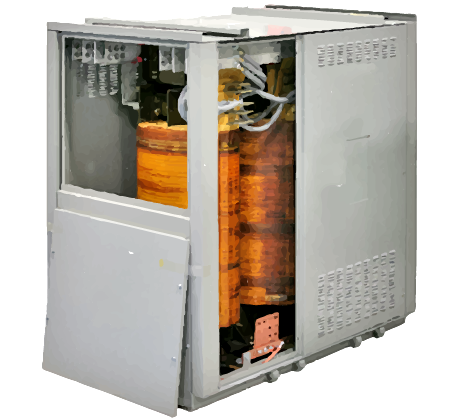Dry-type transformers
Regulations set a minimum energy efficiency level

All dry-type transformers are subject to Canada’s Energy Efficiency Regulations, which set a performance standard for their energy consumption. This helps to eliminate the least efficient products from the Canadian market.
Dry-type transformers and energy efficiency
A transformer reduces the voltage of the electricity supplied to your building to a level that suits the electric equipment in your facility. Since all electricity used by your company passes through a transformer, even small energy improvements in your transformer can yield big savings.
High-efficiency transformers are now available that can reduce you facility’s total electricity use by approximately one percent.
Two types of energy losses occur in transformers: load and no-load losses.
Load losses result from resistance in the copper or aluminum windings. As load increase so do these winding losses and account for 50 to 90 percent of losses at full load. Winding losses can be reduced through improved conductor design, including proper materials selection and more copper conductor employed.
No-load losses result from resistance in the transformer's laminated steel core. These core losses occur whenever a transformer is energized and remain essentially constant regardless of how much electric power is flowing through it. To reduce core losses, high-efficiency transformers are designed with a better grade of core steel and with thinner core laminations than standard-efficiency models. As well, newer transformer core designs use amorphous metal, instead of traditional silicon steel, that reduce core losses by up to 80 percent compared to conventional transformers.
Total transformer losses are a combination of the core and winding losses.
Unfortunately, some efforts to reduce winding losses increase core losses and vice versa. For example, increasing the amount of conductor used reduces the winding losses, but it may necessitate using a larger core, which would increase core losses. Manufacturers are continually developing techniques that optimize these losses based on the expected loading.
Compare current models of dry-type transformers using our searchable product list.
Buying and operating tips
What should you consider when buying a dry-type transformers?
Know your load profile.
Every transformer’s load and no-load loss profile is different. Transformer energy losses depend heavily on precisely how you use equipment in your building. Knowing your building’s load profile will help you choose the best transformer for your facility.
What’s being powered?
The demands of the equipment powered by a transformer will greatly affect the unit’s energy efficiency. Some respond well to linear loads such as those produced by lighting and motors. Others are better suited to operating under non-linear conditions—those produced by electronic equipment and adjustable speed drives.
Understand full-load efficiency.
Do not buy a transformer based only on its ability to perform well at full loads. Since most businesses will run transformers at one-third capacity, you should consider also the transformer’s performance under part-load conditions which can be very different from its efficiency at full load.
Look at more than just temperature rise.
A transformer’s temperature rise tells only part of the unit’s energy-efficiency story. Units with low temperature rises often perform less well under no-load conditions than those with high temperature rises.
Understand transformer losses.
Transformer losses are a combination of load losses and no-load losses. Often, as one type of loss is reduced, the other increases. Get to know how these losses affect usage in your operations.
Page details
- Date modified: